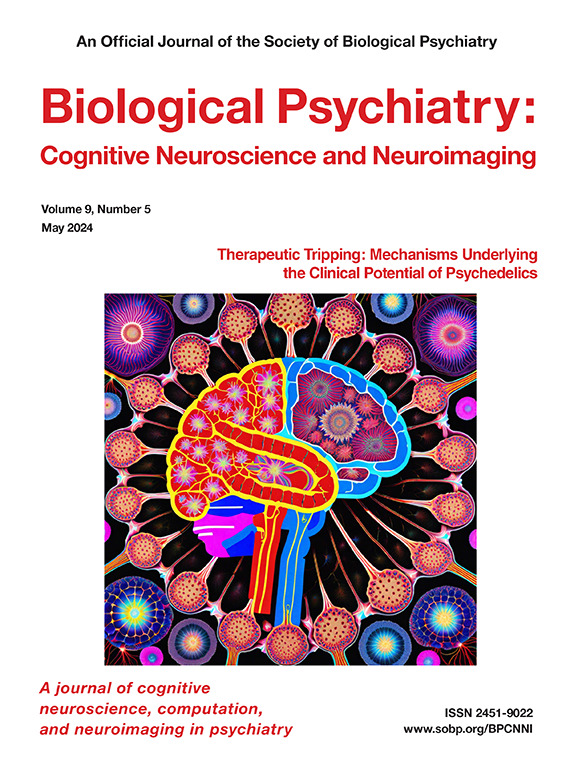预期-情绪神经动力学预测短期和长期抗抑郁药安慰剂效应的机制。
IF 4.8
2区 医学
Q1 NEUROSCIENCES
Biological Psychiatry-Cognitive Neuroscience and Neuroimaging
Pub Date : 2025-08-01
DOI:10.1016/j.bpsc.2025.01.002
引用次数: 0
摘要
目的:抗抑郁药安慰剂效应的急性实验模型表明,在显著性网络(SN)中编码的期望被感觉证据和情绪波动强化。然而,这些动态是否延伸到更长的时间尺度仍然未知。为了回答这个问题,我们研究了在抗抑郁药物预期的加工过程中,SN和默认模式网络(DMN)的功能连接如何促进从SN中的显著归因到上下文线索到DMN中信念诱导的情绪反应的转变,无论是急性的还是长期的。方法:60名无精神药物的重度抑郁症(MDD)患者完成了一项急性抗抑郁安慰剂fMRI实验,在评估每个试验的情绪改善的同时,操纵安慰剂相关预期及其强化,然后进入一项为期8周的选择性血清素再摄取抑制剂(SSRI)或安慰剂的双盲、随机、安慰剂对照试验(RCT)。结果:习得性抗抑郁药物预期通过调节SN-DMN连接的强化学习模型预测。确切地说,更大的调节预示着期望和强化操作对报告的期望和情绪的更高影响。8周后,没有观察到药物对情绪改善的显著作用。然而,相信自己正在接受抗抑郁药的参与者表现出更大的情绪改善,无论实际接受的治疗如何。此外,增加的SN-DMN连接预示着情绪的改善,特别是在安慰剂治疗的参与者中,他们认为自己接受了SSRI。结论:SN-DMN相互作用可能在抗抑郁反应预期、药物分配信念及其对情绪的影响的演变中起关键作用。本文章由计算机程序翻译,如有差异,请以英文原文为准。
Expectancy-Mood Neural Dynamics Predict Mechanisms of Short- and Long-Term Antidepressant Placebo Effects
Background
Acute experimental models of antidepressant placebo effects suggest that expectancies, encoded within the salience network (SN), are reinforced by sensory evidence and mood fluctuations. However, whether these dynamics extend to longer timescales remains unknown. To answer this question, we investigated how SN and default mode network (DMN) functional connectivity during the processing of antidepressant expectancies facilitates the shift from salience attribution to contextual cues in the SN to belief-induced mood responses in the DMN, both acutely and long term.
Methods
Sixty psychotropic-free patients with major depressive disorder completed an acute antidepressant placebo functional magnetic resonance imaging experiment manipulating placebo-associated expectancies and their reinforcement while assessing trial-by-trial mood improvement before entering an 8-week double-blind, randomized, placebo-controlled trial of a selective serotonin reuptake inhibitor or placebo.
Results
Learned antidepressant expectancies predicted by a reinforcement learning model modulated SN-DMN connectivity. Acutely, greater modulation predicted higher effects of expectancy and reinforcement manipulations on reported expectancies and mood. Over 8 weeks, no significant drug effects on mood improvement were observed. However, participants who believed that they were receiving an antidepressant exhibited significantly greater mood improvement irrespective of the actual treatment received. Moreover, increased SN-DMN connectivity predicted mood improvement, especially in placebo-treated participants who believed that they received a selective serotonin reuptake inhibitor.
Conclusions
SN-DMN interactions may play a critical role in the evolution of antidepressant response expectancies, drug-assignment beliefs, and their effects on mood.
求助全文
通过发布文献求助,成功后即可免费获取论文全文。
去求助
来源期刊

Biological Psychiatry-Cognitive Neuroscience and Neuroimaging
Neuroscience-Biological Psychiatry
CiteScore
10.40
自引率
1.70%
发文量
247
审稿时长
30 days
期刊介绍:
Biological Psychiatry: Cognitive Neuroscience and Neuroimaging is an official journal of the Society for Biological Psychiatry, whose purpose is to promote excellence in scientific research and education in fields that investigate the nature, causes, mechanisms, and treatments of disorders of thought, emotion, or behavior. In accord with this mission, this peer-reviewed, rapid-publication, international journal focuses on studies using the tools and constructs of cognitive neuroscience, including the full range of non-invasive neuroimaging and human extra- and intracranial physiological recording methodologies. It publishes both basic and clinical studies, including those that incorporate genetic data, pharmacological challenges, and computational modeling approaches. The journal publishes novel results of original research which represent an important new lead or significant impact on the field. Reviews and commentaries that focus on topics of current research and interest are also encouraged.
 求助内容:
求助内容: 应助结果提醒方式:
应助结果提醒方式:


